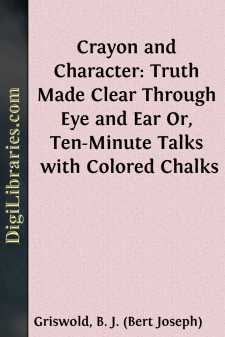Categories
- Antiques & Collectibles 13
- Architecture 36
- Art 48
- Bibles 22
- Biography & Autobiography 813
- Body, Mind & Spirit 142
- Business & Economics 28
- Children's Books 17
- Children's Fiction 14
- Computers 4
- Cooking 94
- Crafts & Hobbies 4
- Drama 346
- Education 46
- Family & Relationships 57
- Fiction 11829
- Games 19
- Gardening 17
- Health & Fitness 34
- History 1377
- House & Home 1
- Humor 147
- Juvenile Fiction 1873
- Juvenile Nonfiction 202
- Language Arts & Disciplines 88
- Law 16
- Literary Collections 686
- Literary Criticism 179
- Mathematics 13
- Medical 41
- Music 40
- Nature 179
- Non-Classifiable 1768
- Performing Arts 7
- Periodicals 1453
- Philosophy 64
- Photography 2
- Poetry 896
- Political Science 203
- Psychology 42
- Reference 154
- Religion 513
- Science 126
- Self-Help 84
- Social Science 81
- Sports & Recreation 34
- Study Aids 3
- Technology & Engineering 59
- Transportation 23
- Travel 463
- True Crime 29
Crayon and Character: Truth Made Clear Through Eye and Ear Or, Ten-Minute Talks with Colored Chalks
Categories:
Description:
Excerpt
The Plan of the Book.
In the preparation of this book the author has had two great plans in mind:
To prepare a work which will enable any person, who can speak to a class or an audience, to give a helpful, inspiring illustrated talk; to place in the hands of parents everywhere a book to enable them to teach the children a simple, fascinating method of drawing and, at the same time make the great truths of life a part of their every-day learning.
Clear instructions are given as to the method of doing these two things. Then come sixty-two complete talks of special appropriateness for Christian teaching. If you are included in the following classes of workers, the book should be of special value to you:
- Speakers who earnestly want to give illustrated talks, but who feel that they "can't draw a straight line."
- Those who are experienced in chalk talk work and are seeking new material.
- Teachers of the Uniform Lessons.
- Teachers of Graded Lessons.
- Sunday school superintendents, for platform work.
- Pastors, for use in prayer meetings and many other services of the church.
- Temperance workers. In this department of work this book is especially worthy of consideration.
- Those who need suggestions to help them work out their own addresses.
- Parents for giving instruction in the home. It is a great truth that such teaching is far more effective than any which the church or the schools may provide.
Scientists tell us that nothing which completely occupies the mind for any length of time is ever forgotten.
This, then, is the reason that the chalk talk method of teaching is so lastingly impressive. People forget everything else while watching a speaker draw a picture. And if they do that, they can never completely forget the words of the speaker or the picture he draws. A baby that doesn't know one letter from another can understand some pictures as well as you can. Try him once and see. And if he lives to be a hundred years of age, he will receive more lasting impressions from pictures than from what he reads. Your audience, therefore, may be depended upon to be "right with you" from the beginning.
The Two-Scene Method.
Added to this feature of securing strict attention, we find in this book another help in the same direction: Every talk is given in two "scenes" or steps. The speaker draws part of the picture, while he speaks, and then, at a little later period, adds the lines to complete the drawing and bring the scene to a climax. In each talk, the upper picture is the first scene, and the lower picture is the second scene, or completed drawing.
The book is planned to encourage the use of sheets of book- or news-paper instead of the blackboard. Paper is used by all leading workers with chalk. To discard the blackboard is to take a forward step. However, if you are "wedded" to the use of the blackboard and can handle it effectively, you will find all but a small number of these illustrations adapted to your method.
Materials Are Cheap.
Probably your school or church is already supplied with the necessary apparatus to do all the work as planned in this book. However, for any who may need to provide for himself a drawing board and easel, instructions for making them are here given. It is only necessary, then, to procure drawing paper and chalk. These are cheap in price and easy to get. You are urged, therefore, to proceed with the use of drawing paper as here instructed, and to lay aside the blackboard for the more advanced method.
Each drawing in the book, as already stated, is given in two "scenes," in order to show you how your drawing will look when it is partly finished (first scene), and how it will look when it is completed (second scene).
If you are at all "bashful" about taking up the work, let us make this suggestion: In the seclusion of your home or elsewhere, draw the first scene of your talk completely. Thus you will have plenty of time to make it to suit you, with no one to look on and fluster or confuse you. Then cover up the completed work, by placing another sheet of paper over it. When you appear before the audience to give your talk, give your spoken introduction and lead up to the first scene. At this point, remove the cover paper and expose your drawing. Proceed with your talk until you reach the climax in the second scene, at which time you give the picture the final lines with your crayon....


